Corsair Vengeance LPX 16Go DDR4 2666MHz: Review |Specs | Price | CPU Performance| Hashrate| Setup| Configuration | Advantage (Pros) and Disadvantages (Cons) and other important features that will help you make better decision.
After a DDR3 memory kit from Kingston (the HX318C10FRK2 / 8) I will attack directly in the heavy, namely DDR4! It is Corsair which opens the ball with a kit of 4 strips of 4go “Quad Channel” that is to say 16Go at a frequency of 2666 MHz, one of the differences with the DDR3 is the lowering of the tension which passes from 1.35V-1.65V at 1.2V, which will mean lower consumption and the heat released.
For the moment, DDR4, given its youth, is reserved for the X99 chipset (like the Gigabyte X99 Gaming 5 tested here) equipped with a Haswell-E processor, namely the Intel core i7 5820K, 5930K and 5960X, therefore an expensive configuration. The Corsair Vengeance LPX 4 x 4 GB 2666MHz kit can be found around € 270 which is really not within the reach of everyone but is average for this type of product, knowing that the memory has always been extremely expensive at launch.
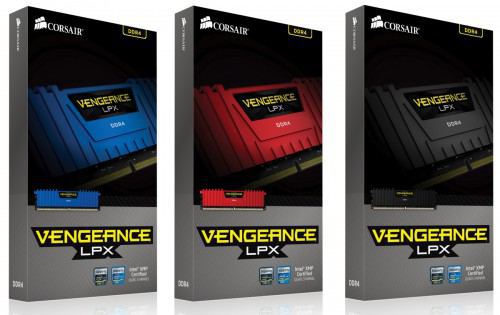
The Vengeance LPX range from Corsair is only made up of kits of 4 DDR4 strips specially designed for the “Quad Channel” and in “low profile” format in order to be compatible with the maximum of heatsinks. Of course, aluminum radiators are included, although given the low voltage there is certainly no need for them.
It will be possible to find kits ranging from 16GB to 64GB for speeds of 2133MHz to 3000MHz and a voltage of 1.2V (1.35V for 3000MHz kits). Of course Corsair has thought of fans of mods and boxes with a window by offering its kits in 3 colors, black, blue or red in order to satisfy the greatest number!

Each kit is compatible with the XMP 2.0 standard which allows automatic overclocking even simpler than the XMP which equips DDR3 kits, overclocking yes because Haswell-E processors have an integrated memory controller supporting DDR4 up to 2133MHz, beyond that will be overclocking. Let’s see the technical characteristics of the kit tested today:
Specification: Corsair Vengeance LPX DDR4 4 x 4 Go 2666 MHz
| Corsair Vengeance LPX DDR4 4 x 4 Go 2666 MHz | |
|---|---|
| Modèle | CMK16GX4M4A2666C15R |
| Type de mémoire | DDR4 |
| Nombre de barrettes | 4 |
| Capacité totale | 16 Go |
| Dissipateur | Vengeance LPX rouge |
| Vitesse SPD | 2133 MHz |
| Latence SPD | 15-15-15-36 |
| Tension SPD | 1.2V |
| Vitesse testée | 2666 MHz |
| Latence testée | 15-17-17-35 |
| Tension testée | 1.2V |
| Garantie | A vie limitée |
| Prix | ~ 270€ |
Today’s test kit is therefore a DDR4 kit with red radiators for a total capacity of 16GB. We learn that the memory runs at 2133MHz for a latency of 15-15-15-36 and a voltage of 1.2V without the XMP 2.0 profile activated. The strips have however been tested for 2666MHz with a latency of 15-17-17-35 and a voltage of 1.2V, this means that if you plug in the kit without touching the bios the speed will be 2133MHz.
Offered at a price of € 270, this is a lot for a 16GB memory kit (double the DDR3), but the youth of the technology as well as the low production volumes largely explain this price.
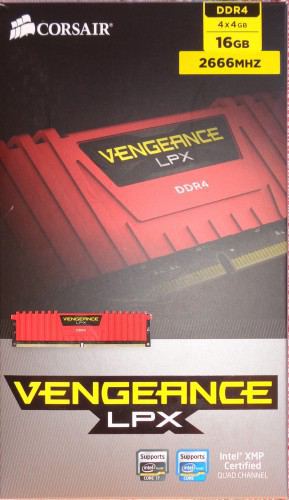
The box presents a photo of a memory module as well as the model, frequency, number of modules and type of memory (DDR4), a mention of XMP compatibility is also included. No excessive marketing here touting the superiority of the memory kit, it’s not a bad thing!
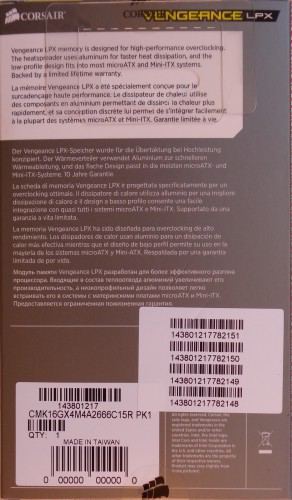
At the back a small summary of the strengths of the kit such as the high performance overclocking (XMP profiles) as well as the “low profile” aluminum heatsinks particularly suitable for micro and mini-ATx configurations, even if in the end it is just as suitable for ATX configurations.

Inside there are 2 welcoming plastic boxes each 2 memory sticks, everything is well protected there should not be any problems during transport.
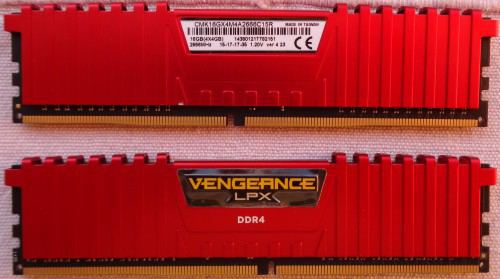
And here is the beast! A small “Vengeance LPX” on one side and the model and settings on the other side. The radiator is very well finished and exudes quality, the paint is also applied very well.
Note that unlike DDR3, DDR4 strips do not have a straight PCB at the level of the pins, in the center the pins are longer than on the sides, see instead:

I imagine that the reason must be a decrease in breakage with a design like this, in the end it doesn’t really change much!

In case the box is lost or the desire comes to adjust the timings by hand, everything is present on the small sticker of each bar.

Above you can see the small “Corsair” in white letters printed on each bar, the curious must see who is entrusted with the memory in the PC 😀
The test platform
Corsair Vengeance LPX 4 x 4 GB CMK16G4M4A2666C15R memory kit has been tested with the configuration below:
- Processor : Intel Core i7 5820K
- Ventirad Processor : Noctua NH-D15 (tested here)
- Motherboard : Gigabyte Gigabyte X99 Gaming 5 (tested here)
- Disque dur: WD Raptor 150 Go
- Graphics Card : Sapphire HD7950
- Ventirad Graphics Card : Prolimatech MK-13
- Alimentation: be quiet! E9 580CM
The software used will be as follows:
Profils XMP et Overclocking
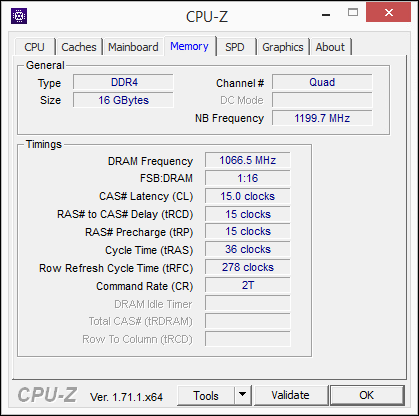

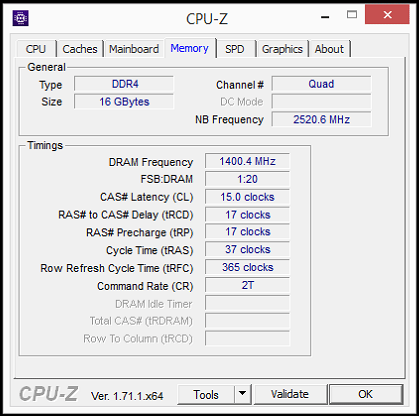
The kit is therefore delivered with a base rate of 2133MHz but also with 2 XMP profiles, the first displays 2666MHz for latencies of 15-17-17-35 at a voltage of 1.20V but the second is 2800MHz for latencies of 15-17-17-37 at 1.35V. The second XMP profile is not officially supported because it may not be compatible with all motherboards, but it doesn’t cost a thing to try it!
A noter: XMP profiles also overclock the processor if it is automatic, basic (and with 6 cores supported) the Core i7 5820K runs at 3.4 GHz (34 x 100), with the XMP 1 profile it runs at 3.6 GHz (36 x 100) and the XMP 2 profile runs at 3.8 GHz (36 x 105)! Normally the speed should not be affected with the XMP 1 profile but strangely the turbo mode goes from 34 to 36, maybe a bug in the bios of the Gigabyte motherboard in the test, I would see this with Gigabyte and update a once I would have had an answer. With regard to the XMP 2 profile, the multiplier coefficient being at most 26.66 (therefore 26.66 x 100 = 2666 MHz at most) the FSB must then be increased from 100 to 105 to arrive at a frequency of 2800 MHz,
In short, what to do? First I will do a series of tests without touching the settings, like someone who would buy the kit, which would activate the XMP profiles without anything else and then I will manually set the frequency of the processor to 3400 MHz, like it should be. Having no other motherboard on hand I could not say if this behavior is normal.
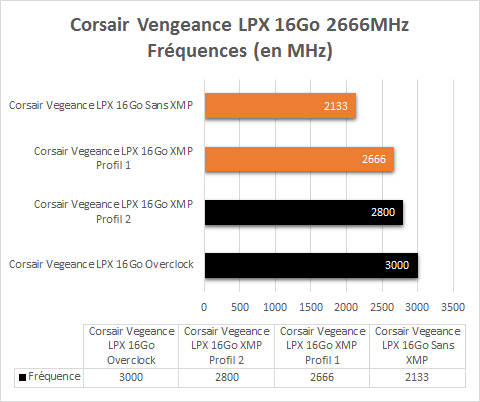
By increasing the timings a little to 16-18-18-39 still at a voltage of 1.35V I was able to stabilize the kit at 3000 MHz, which is not that bad for a kit sold to run at 2666 MHz. Beyond that it resulted in the impossibility of starting the machine, either with a higher tension or looser timings.
Aida64
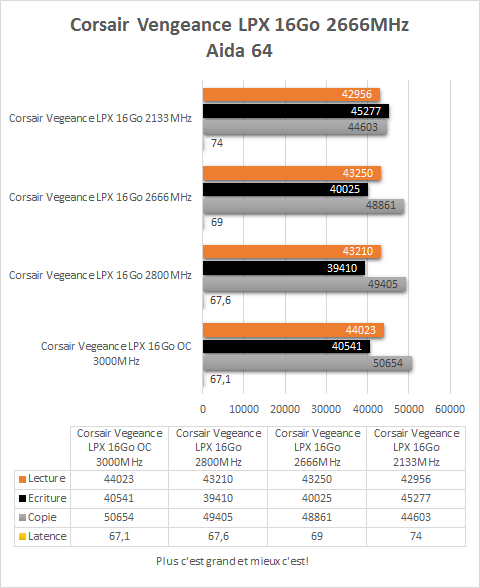
Strangely Aida64 doesn’t seem to like the ramp up on the Gigabyte X99 Gaming 5, I would update this info when I could get my hands on another X99 motherboard, only the copy results go up at the same time as the frequency increasing from 44.6 Gb / s to 50.6 Gb / s from 2133 MHz to 3000 MHz.
Cinebench R15
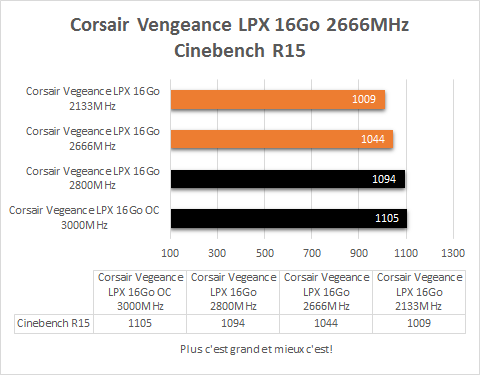
Under Cinebench R15, on the other hand, the increase in frequency is felt, we go from 1009 when the kit is clocked at 2133 MHz to 1105 once at 3000 MHz, a significant gain during large calculations.
Handbrake

Same observation with Handbrake, the kit saves a few seconds when overclocked, 83s to encode the file at 2133 MHz and 74s once at 3000 MHz, the gain is there.
WinRAR
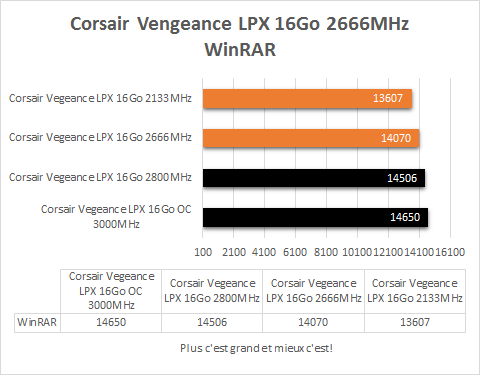
WinRAR is also particularly fond of the frequency increase, 13607 points when the frequency is 2133 MHz and 14650 points at 3000 MHz. Like the other tests there is very little gain however between 2800 MHz and 3000 MHz due to the slackening of the timings.
WPrime
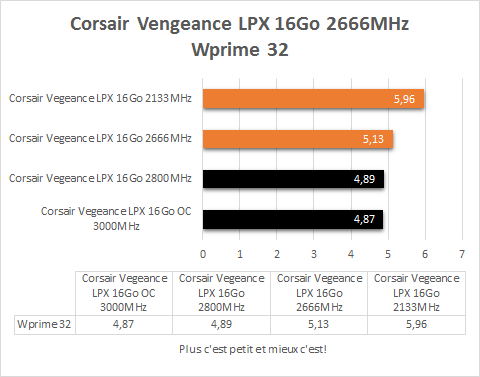

WPrime also likes high frequencies, on the 32M test the calculation goes from 5.96s at 2133 MHz to 4.87s once overclocking is applied. Once again the performance is excellent at 2800 MHz and the gain is marginal once the kit has been pushed to its limits. In version 1024
3DMark and Games

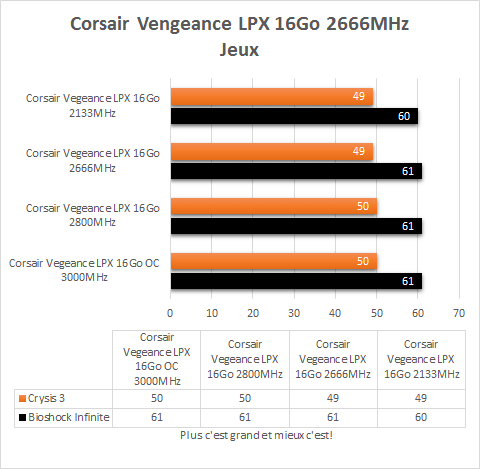
Like the other tests under 3DMark Fire Strike Physics the scores go up well with the increase in frequency from 12886 to 14430. In games on the other hand, and logically the number of FPS changes only marginally, nothing that could really be convincing.
Aida64
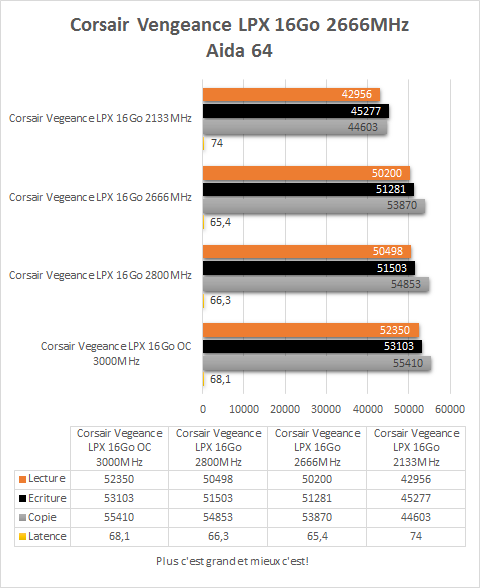
Ah! That is better, the strange results obtained by letting the motherboard manage the frequencies are only a distant story, here the bandwidth increases well with the increase of the frequency! A big gain is observed by going from 2133 MHz to 2666 MHz, the bandwidth goes from 43-45 Gb / s to 50-54 Gb / s, which is really not nothing! Beyond and with the relaxation of timings, the gains are not necessarily very convincing.
Cinebench R15
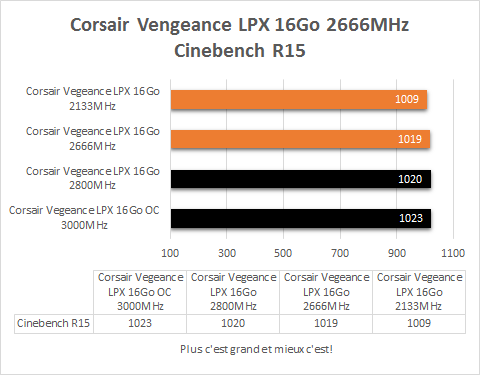
Under Cinebench R15 the results are quite different now, we only gain 10 small points going from 2133 MHz to 2666 MHz, and a few more small points from 2666 MHz to 3000 MHz. The memory then has little influence, even if the gain is indeed there it is only about 1%.
Handbrake

Under Handbrake we gain 2s by going from 2133 MHz to 2666 MHz, at 2800 MHz we are only 1s saved compared to the original frequency of 2133 MHz, certainly due to the relaxation of the timings once again.
WinRAR
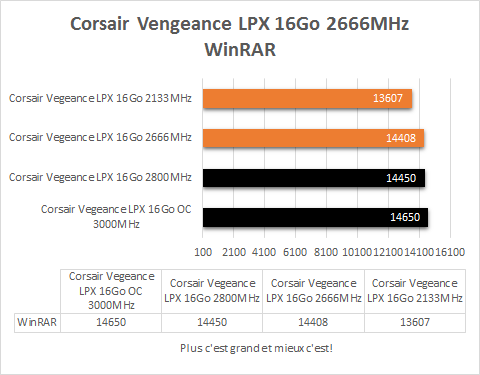
WinRAR seems particularly fond of the increase in bandwidth, 13,607 points of origin we go to 14,408 once at 2666 MHz to go up to 14650 once the kit from Corsair is overclocked to the maximum.
WPrime
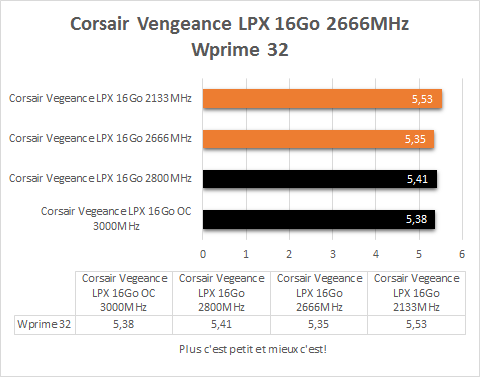
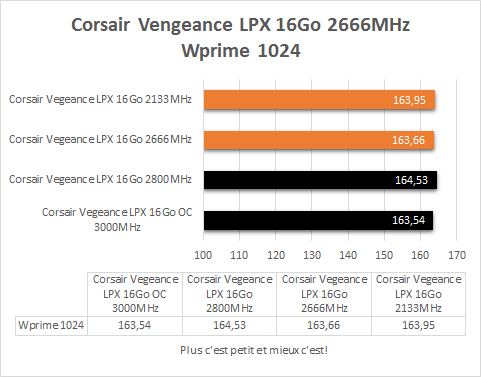
We observe a small gain going from 2133 MHz to 2666 MHz under Wprime, whether 32M or 1024M, beyond the scores are less good than at 2666 MHz, Wprime must be sensitive to latency and therefore it results poorer results at 2800-3000 MHz.
3DMark and Games
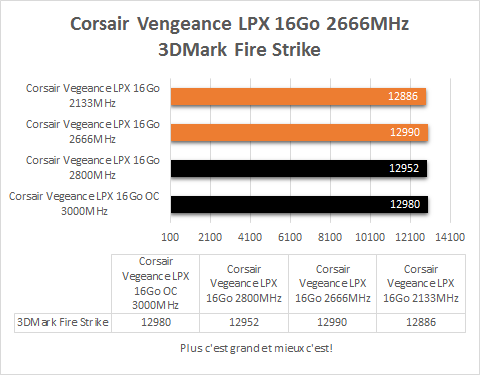
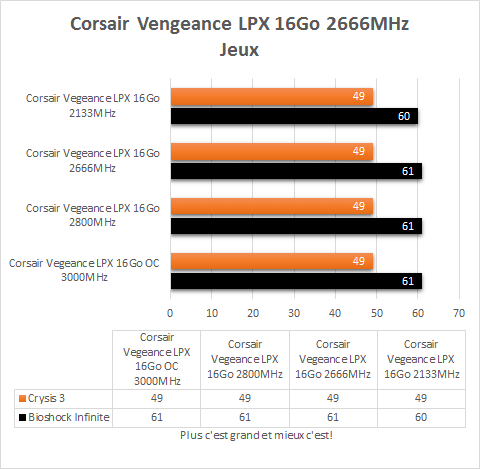
Under 3DMark Fire Strike (Physics) a small gain is to be observed while going from 2133 MHz to 2666 MHz, results which stagnate after this past frequency. In play and as usual, the gain is marginal when there is a gain, nothing that is out of the ordinary though.
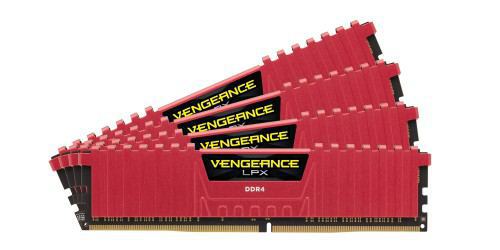
Here we are at the end of this test, what about the Corsair Vengeance LPX 4 x 4 GB CMK16G4M4A2666C15R kit?
The choice of memory has very little influence on the overall performance of the machine, what is most important is stability, who would want to end up with PCs that freeze up or make blue screens? Corsair being a major player in terms of memory, and this was its only domain for a very long time, offers a really very good 4 x 4 GB 2666 MHz DDR4 kit, both in terms of performance and stability.
The technology being rather young bugs are to be expected, as the XMP profiles managed in a strange way on the Gigabyte X99 Gaming 5 of the test which automatically overclock the processor without having any stability problem however, a bios update should resolve the issue transparently.
Let’s talk about the subject that is angry now, the price! Like any new technology, this comes at a high price, indeed with around 270 € for 16GB it hurts, very badly! Nothing that changes the competition, however, to be reserved for owners of high-end processor and motherboard (you have no choice anyway if you switch to socket 2011-3!).
Advantages
- Performances
- Overclocking
- Automatic setup
- Different colors
- Guarantee
A big thank you to Corsair and Gigabyte who allowed me to do this test.















